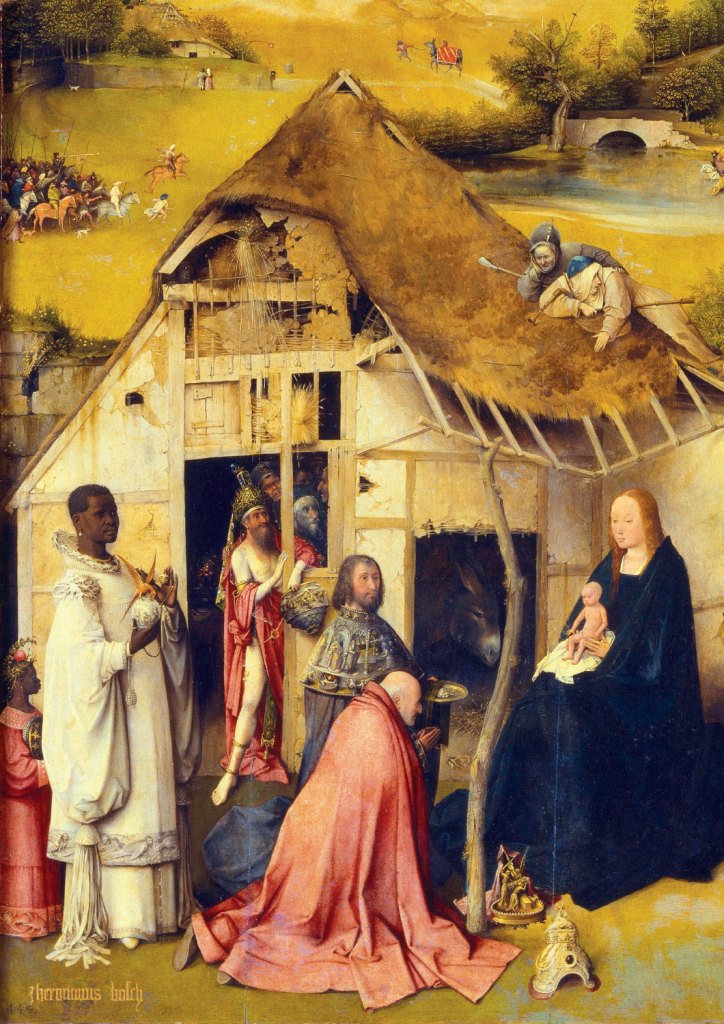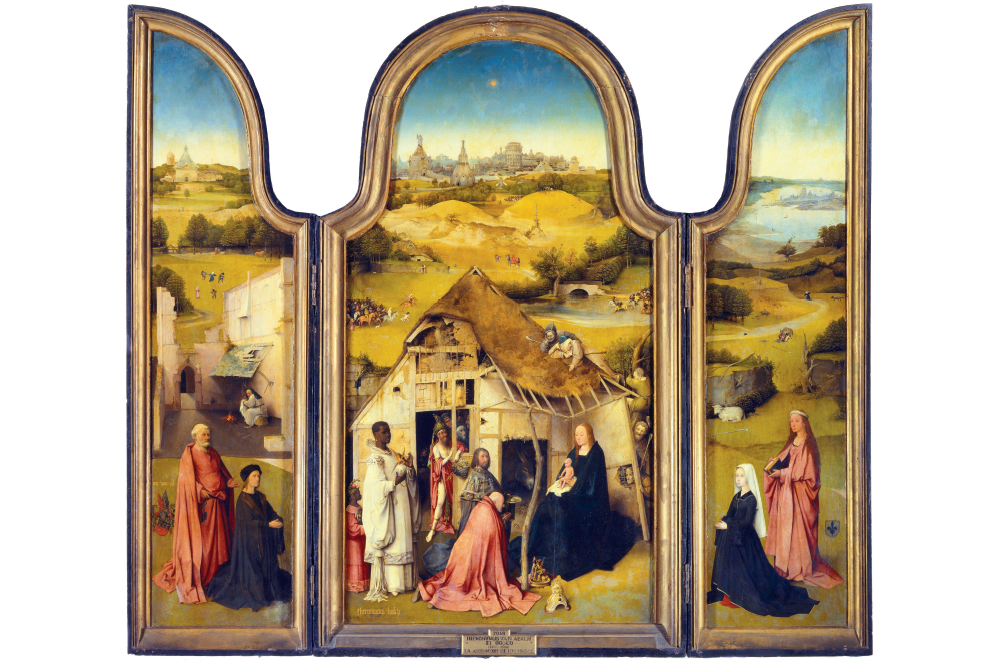Hieronymus Bosch was not a natural painter of religious images. His terrifying visions of Hell may have helped to keep congregations on the path of righteousness, but they did not inspire feelings of devotion – which could explain why none of the large altarpieces he painted remained over their altars after his death. In the eyes of the church, his Last Judgments were titillating: one painting showing ‘monstrous creatures from the underworld’ was removed from a church in his native ‘s-Hertogenbosch during his lifetime by officials offended by its orgy of nudity. Even his ‘Adoration of the Magi’ (c.1494) did not stay long above the Antwerp altar for which it was painted; it was snaffled by Philip II for his collection and now hangs with ‘The Garden of Earthly Delights’, and ‘The Haywain Triptych’, in the Prado.
This ‘fourth king’ has crashed the baby shower with dodgy-looking mates who are crowded behind him
Devotees of surrealism who make the pilgrimage to Madrid to worship before these two famous paintings don’t tend to linger over the master’s ‘Adoration’ which – with its dearth of monstrous creatures – appears disappointingly conventional. At first glance it has all the standard ingredients: dilapidated stable, splendid kings, sweet-faced Virgin and Child and, around the corner, a dutiful Joseph – in the absence of a midwife – drying the towel used at the birth over a fire.
So far, so relatively traditional. On closer inspection, though, some elements are missing – there are no angels and, mysteriously, no ox. But more disturbing than these omissions is the addition of what appears to be an extra king. Standing inside the entrance to the stable, between the black king Balthasar and the other two, is a curious figure in a bizarre headdress wearing an off-the-shoulder red cloak and very little else (detail of the central panel below). His face and neck are tanned but the rest of his body is deathly pale, and he has an oozing wound on his right leg encased like a reliquary in a crystal sheath. Between his legs a bell hangs on a ribbon embroidered with frogs, and in his left hand he holds a helmet resembling a papal tiara which seems to belong to Melchior kneeling in front of him. The tiara is decorated with a frieze of little trolls tormenting some herons – one of which bites back – while his own headdress is wreathed in a crown of thorns and topped by a crystal tube in which the thorns are blooming. Unlike the three kings who – apart from Balthasar with his page – are unattended, this ‘fourth king’ has crashed the baby shower with a gang of dodgy-looking mates who are crowded into the stable behind him, where – judging by the fire and soup bowl in the murky background – they appear to have set up camp.

Who is this pantomime villain with his consigliere, a horrid old man with a purple face and bright red nose? He is the Antichrist, the false Messiah sent to mislead the Jews in punishment for their failure to recognise the true one, and he is indulging in a bit of Christological cosplay in his red cloak and crown of thorns mimicking the Passion. Painted over a previous figure of an elderly man leaning on a staff, it’s possible that this intruder could have been added at the request of the painting’s commissioner Peeter Scheyfve – who appears on the left wing with his patron Saint Peter, across from his wife Agneese de Gramme with her patron Saint Agnes on the right – but the note of devilry he strikes smacks of Bosch. Even when heralding the birth of the Saviour, Bosch can’t resist sending shivers down the spine.
Even when heralding the birth of the Saviour, Bosch can’t resist sending shivers down the spine
In Christian eschatology the Antichrist is a charlatan who uses magic tricks – like making dead thorns bloom – and money to deceive and corrupt the three kings of the world (rulers of the three known continents), thereby unleashing the turmoil that precedes the Second Coming. Over the head of the false prophet, a tuft of straw tied to the gable truss fans out in rays like a fake star, a shoddy knock-off of the celestial body announcing the genuine Saviour’s birth in the sky above. With his jester’s bell the Antichrist looks like a fool, but Bosch warns that we laugh at his wiles at our peril: he is as dangerous, he hints, as the unblinking owl in the shadow of the gable above his head with the lizard in its claws.
Not content with admitting this spectre to the Nativity feast, Bosch even dares to cast shreds of doubt on the three kings. Their attitudes are respectful and their gifts are scripturally on-message, but the devil is in the detail. Caspar’s gold ornament portrays the sacrifice of Isaac, prefiguring Christ’s sacrifice on the Cross, but it stands on a base supported by toads. Balthasar’s pot of myrrh is decorated with an image of the peace-making Abner kneeling before David, and the phoenix perched on its lid with a pomegranate seed in its beak is a portent of the Resurrection, but the border of his page’s robe is embroidered with the demonic motif of a fish with legs – the only monster to appear in the picture. Bosch doesn’t let us forget that the kings are pagan, and they’re not the only ones under suspicion. The behaviour of the shepherds – also added as afterthoughts, like the Antichrist – seen scrambling up a tree and clambering onto the roof for a better view, is less than reverential. They haven’t come to adore the Christ Child; they’ve come to gawp. Only one, peering through a hole in the stable wall with a grave expression, seems to have grasped the momentousness of the occasion.
These disrespectful yokels aren’t even good shepherds: they’ve left a sheep at the mercy of two wolves, seen mauling a man and pursuing a woman in the background landscape on the triptych’s right wing. The miracle taking place outside this stable hasn’t permeated to the wider world. On the left wing, behind the figure of Joseph, a Hammer-Horror gothic arch topped by a hand-standing frog leads to a field where ribald peasants dance rambunctiously. From the posture of one peasant and his partner’s reaction, you’d swear he was exposing himself (if so, he must be the only flasher in an altarpiece). In the centre, behind the stable’s pitched roof, a monkey riding a mule is pulled towards an inn identified as a brothel by the swan on its banner. Christ may be born in Bethlehem, but life goes on.
On either side of the roof, meanwhile, two bands of warriors advance from opposing directions; another band rides out from the cover of a hill behind. Unlike the traditional trains of attendants attending to the three kings, these armed bands are clearly looking for a fight. Some historians have identified them as Herod’s soldiers out looking for the baby Jesus, but they could also represent the warrior hordes heading for the final showdown at the end of days: the ‘kings of the earth, and their armies’ from Revelation. On the far horizon, behind a high wall, glimmers a weird and wonderful vision of the Heavenly Jerusalem. It’s a long way there, over desert terrain roamed by wild beasts and marauding armies, but the hope is that, thanks to the miracle revealed to the three kings, humanity may eventually make it.
Bosch celebrates redemption, while reminding us that salvation is not in the bag. His ‘Adoration of the Magi’ is a morality panto with a warning message that the world is full of false prophets and tricksters – the Devil’s emissaries are present even at the Epiphany. You feel like shouting to his three kings: ‘Look out, they’re behind you!’
Copies of Bosch’s ‘Adoration of the Magi’ can be found at Upton House, Warwickshire, and at Petworth House, West Sussex.






Comments